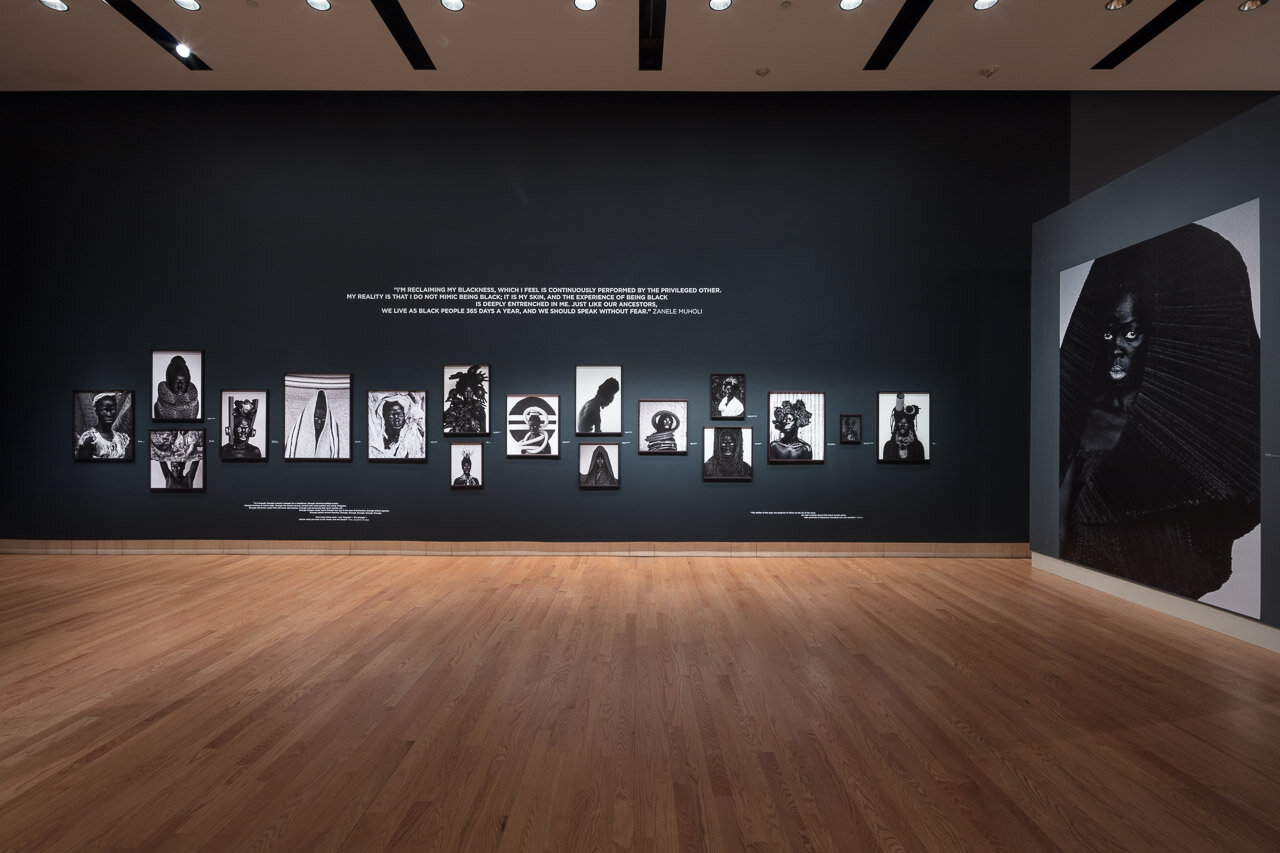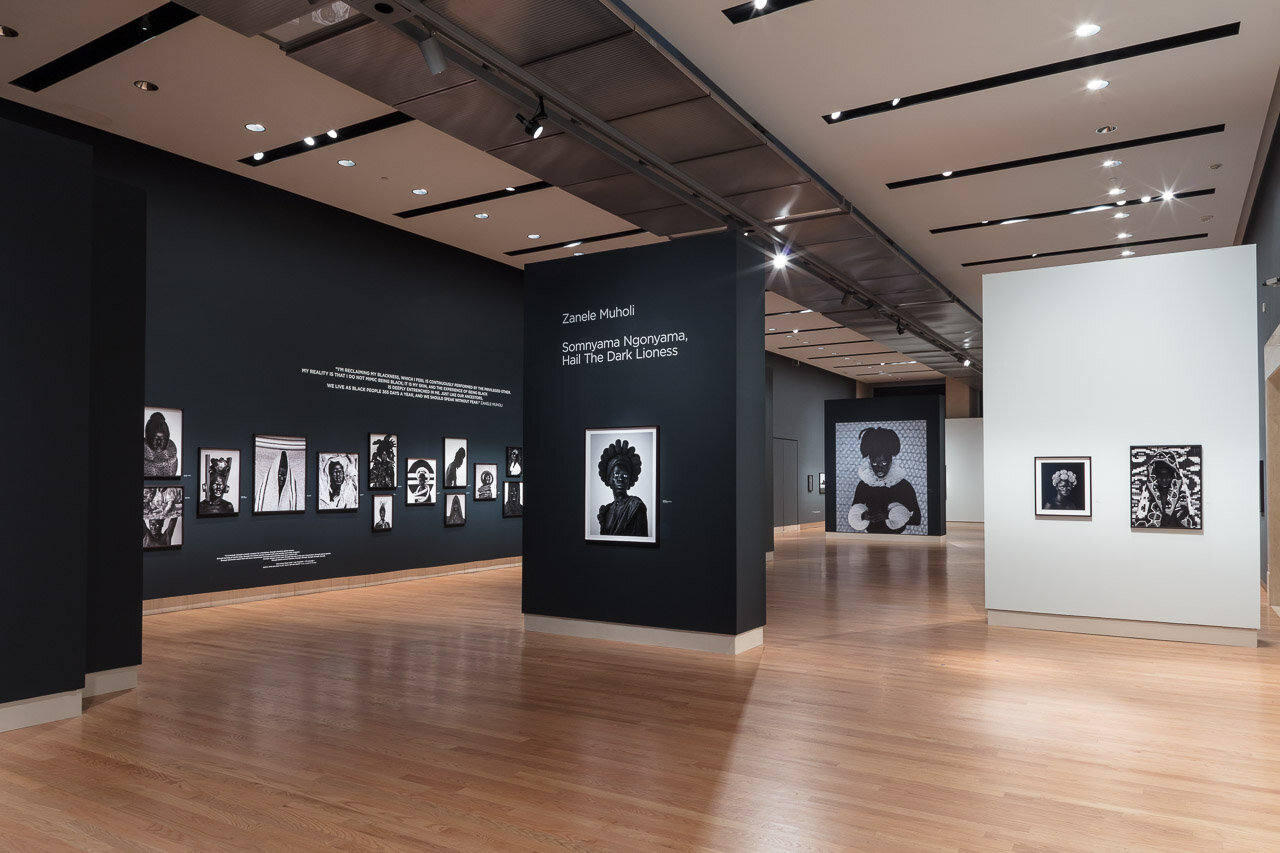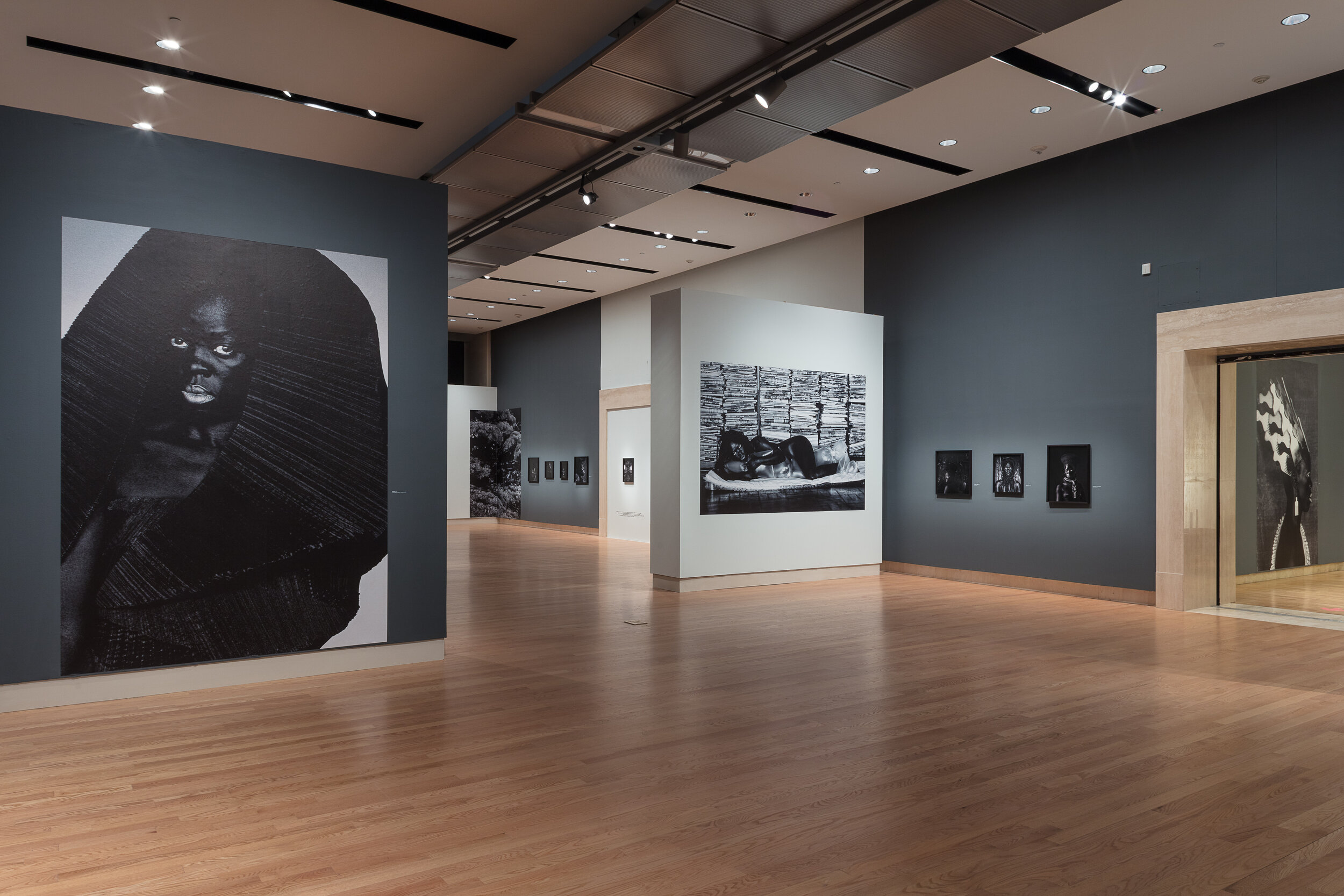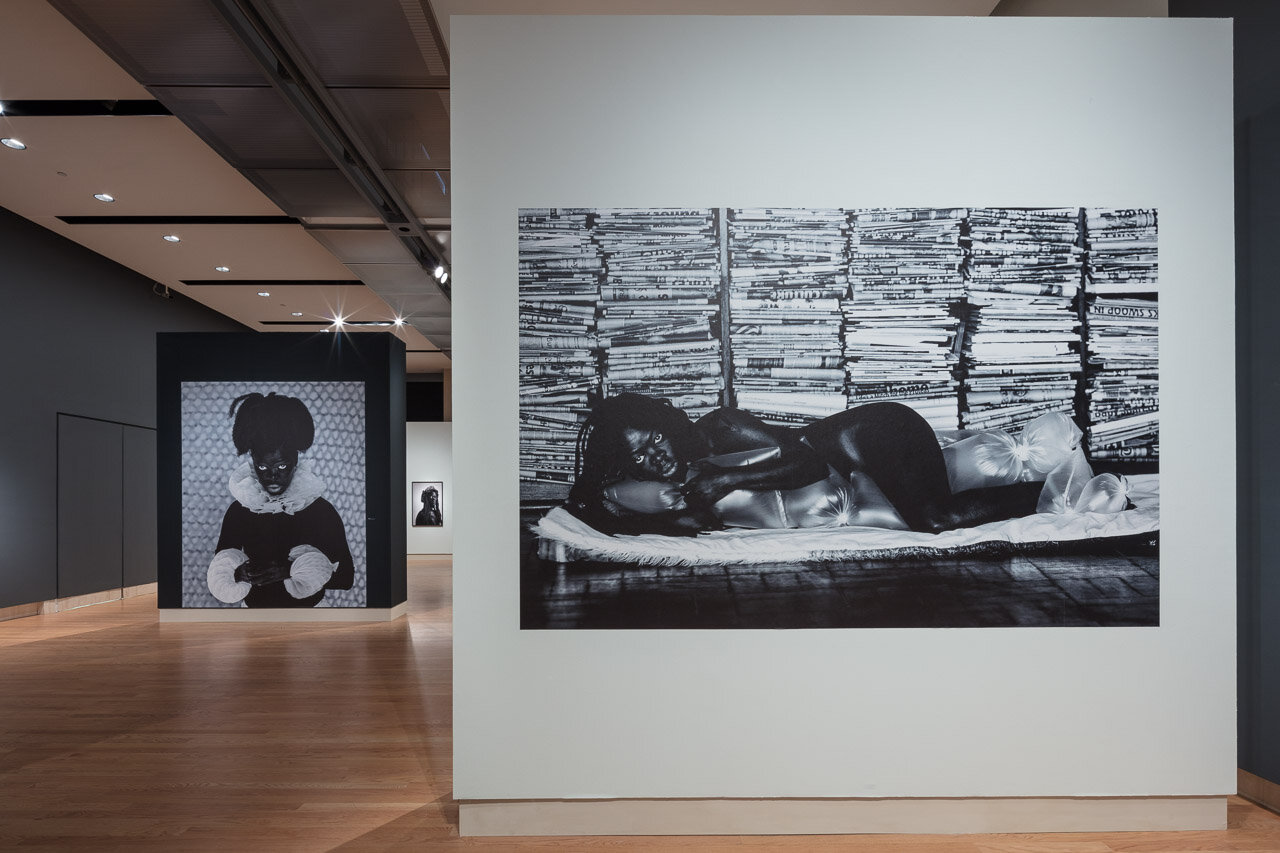Florida writer Zora Neale Hurston once said, “I feel most colored when I am thrown against a sharp white background.” Nikesha Elise Williams had a similar feeling at an exhibit at the Cummer Museum of Art & Gardens in Jacksonville, Florida.
by Nikesha Elise Williams
~ Listen to the Story ~
This is the Blackest thing I’ve ever seen.
This is my first and most recurring thought as I approach the Cummer Museum of Art & Gardens in Jacksonville, Florida, to preview “Somnyama Ngonyama, Hail the Dark Lioness,” a photography exhibition by South African visual activist artist Zanele Muholi.
“Somnyama Ngonyama II” is the image that greets visitors approaching the museum. Turned into a banner and hung on either side of the museum’s doors, it is a visual cue to those who enter the halls of the prestigious institution that the main attraction is blackity-Black — which is to say that it is super-Black, that it boldly and unapologetically centers a range of Black cultural aesthetics, sensibilities, and historical experiences across the diaspora. Seeing the image up close, stretched across an entire wall inside the main gallery, is even more striking. The portrait is mounted as wallpaper, like several other large-scale images in the show. The smaller portraits throughout the gallery are framed without glass. No velvet ropes force visitors to keep their distance from Muholi’s work. The museum staff asks people to stay 4 feet away. But with such intimate images, you can’t help but inch a little closer, centimeter by centimeter, to process what you’re looking at and, in turn, who and what is looking back at you.
The self-portrait of Muholi draws you in. Muholi is nonbinary and uses the pronouns they/them. Their stare confronts. It agitates. It dares the viewer to question whether Muholi is a queen. The yarn or wool-like material draped around their head rests on their shoulders. That softness is juxtaposed against the strength in their face: the angles of their cheekbones, the tension across their forehead, the slight flaring of their nostrils, and the relaxed purse of their lips. Muholi is regal.
Somnyama Ngonyama II, Oslo, 2015 © Zanele Muholi. Courtesy of Stevenson, Cape Town/Johannesburg and Yancey Richardson, New York
Sebenzile, Parktown, 2016 © Zanele Muholi. Courtesy of Stevenson, Cape Town/Johannesburg and Yancey Richardson, New York
Five portraits in the collection bear the name Somnyama, which is the isiZulu word for “dark.” “Somnyama is a living being, who deserves respect, who deserves recognition,” Muholi said when the exhibition premiered in London in 2017.
This is where Muholi’s activism is activated. “Somnyama Ngonyama, Hail the Dark Lioness” is an internationally touring exhibition of more than 80 self-portraits. Muholi is based in Johannesburg, South Africa, but their portraits were taken all around the world. Every portrait in the exhibition has a name derived from Muholi’s life and experiences.
The image series “Bester,” for instance, is named for Muholi’s mother, who was a domestic worker. Props in this series include clothespins, scouring pads, and large, wide fabric to show the layers of domesticity. Some of these props are used to create crowns to signify the dignity in this labor. In the show program, Muholi says, “The ‘Bester’ portraits are talking about abuse and the trauma that most maids experience at the hands of their employer.” In “Bester” and a series titled “MaID” (My Identity) that looks like the word “maid,” Muholi interrogates titles, labels, roles, and purpose of place, a throughline that continues throughout their work.
The series “Bayephi” includes three images taken at Constitution Hill, a former prison complex in Johannesburg. Some self-portraits carry names that evoke the place where they were taken. In “ZaKi” Muholi is photographed in a kimono in Kyoto, Japan.
In “Bona, Charlottesville” Muholi is photographed on a bed while looking in a mirror. The portrait was taken in Charlottesville, Virginia, in 2015. “Bona,” which means “to see” in isiZulu, is one of my favorite portraits in the show. That Charlottesville was the site of the white supremacist Unite the Right rally just two years later makes me wonder how the image and the event connect to each other.
And that is the goal in Muholi’s work: to make us look beyond the beauty in the image. Yes, they are breathtaking, but what are they saying? What are the layers of conversation, of connection, that each image has to the artist and the world they inhabit? A world of hate, racism, bigotry, discrimination, classism, and a polluted environment. What are they saying in these portraits of their unaltered Black body and bright white eyes — a contrast the artist heightens with a post-production edit so the blacks look blacker and the whites look whiter?
Muholi says, “Contrast is about difference. What does the use of high contrast mean in relation to black skin?” They answer their own question in another statement placed high on one of the first gallery walls inside the Cummer exhibition.
“I’m reclaiming my Blackness, which I feel is continuously performed by the privileged other. My reality is that I do not mimic being Black, it is my skin, and the experience of being Black is deeply entrenched in me. Just like our ancestors, we live as Black people 365 days a year, and we should speak without fear.”
No velvet ropes force visitors to keep their distance from Zanele Muholi's revelatory self-portraits. "I'm reclaiming my Blackness," says the Johannesburg-based artist. The exhibit of 80 works continues at Jacksonville's Cummer Museum of Art & Gardens through June 20.
This is the Blackest thing I’ve ever seen.
This is my only thought as I tour the exhibition with other media professionals (only one other member of the press is Black). As we are guided through the exhibition and told about the layers and depth revealed in the materials used, including a vacuum hose in “Sebenzile, Parktown,” or bright, exaggerated lipstick in “Vile, Gothenburg, Sweden,” I see the layers from minstrelsy to royalty, from domestic labor to dominion.
Muholi is in complete control over their Black body and how it is gazed upon. They say, “In a majority of the portraits, I am looking direct, but in others, I am not even looking, or I’m looking away. … For me, in most cases it’s my own way of self-defense.” It is in fact a declaration of freedom. The control of the gaze, whether straightforward or averted, is indeed a form of Black liberation. That Muholi discusses the Black experience from bondage (using zip ties in “Bhekezahke, Parktown” or rubber in “Ziphelele, Parktown” and “Basizeni XI, Cassilhaus, North Carolina”) to freedom (in “Bona” or “Ntozakhe II, Parktown”) is simultaneously powerful and overwhelming.
In a space of whiteness, surrounded by white faces, Blackness is all I see. By the time the Cummer Museum’s new executive director and CEO, Andrea Barnwell Brownlee, arrives in the exhibition hall to take our questions, this singular thought burns in my brain. Before taking the helm at the Cummer in December 2020, Brownlee was curator for the Museum of Fine Art at Spelman College (her alma mater), a museum dedicated to exhibiting the work of Black women artists. When she buzzes into the room, brown skin, thick-bodied, with artfully chunky and geometrically bangled wrists, my thought intensifies.
Ntozakhe II, Parktown, 2016 © Zanele Muholi. Courtesy of Stevenson, Cape Town/Johannesburg and Yancey Richardson, New York
Bester I, Mayotte, 2015 © Zanele Muholi. Courtesy of Stevenson, Cape Town/Johannesburg and Yancey Richardson, New York
This is the Blackest thing I’ve ever seen.
My thought is a refrain as I listen and take notes while Brownlee answers questions about how the exhibition came to Jacksonville. The exhibition “Sporting Fashion: Outdoor Girls From 1800 to 1960” was delayed because of COVID-19. Brownlee had a personal relationship with Muholi and called in a favor, making “a lemon martini out of the lemon,” as she puts it. In doing so, she was able to express her point of view and the direction in which she would like to lead the museum.
Tentatively, I raise my hand and say the thought that has gripped me from the moment I stepped onto the grounds. “This is the Blackest thing I’ve seen in this space in the 10 years I’ve lived in Jacksonville. Was that intentional?”
“Yes,” Brownlee says. Because the museum had exhibits booked for the next three years, Brownlee, who had just begun her tenure, would not have had the opportunity to distinguish her leadership and curatorial style from that of her predecessors until sometime in 2024, if not 2025. By bringing in “Somnyama Ngonyama, Hail the Dark Lioness,” she was able to put forth her intention: “Whatever happens in this space, at this time, I did want it to be about a Black artist,” she says.
That championing is encouraging for Black visual artists in the city. Traci Mims, a visual artist who does astounding drawings in pencil and crayon, says: “That it was at the Cummer … I’ve never seen anything that Black outside of the Ritz.”
In Jacksonville, the Ritz Theatre and Museum is the place to go to see Black culture in a historical context and Black art in a gallery. “Through Our Eyes,” an annual art exhibition started 28 years ago by administrator Lydia P. Stewart, is sometimes the only opportunity for Black artists in the city to show their work in a gallery space.
“I've been in this city almost 30 years, and up until this year, I've never been able to show at the Cummer,” Mims says. Her work was recently shown in the Cummer Museum as part of the Art Ventures 30th Anniversary Exhibition for artists who received an Art Ventures grant from The Community Foundation for Northeast Florida.
Fine art photographer Cheryl “Obscura Lux” McCain says seeing the Muholi exhibit makes her believe that one day she, too, as a Black photographer, can exhibit her work inside the esteemed museum. “To be in the Cummer — it really speaks volumes at the direction and the changes that they are making. It's important, because representation matters.”
Accompanying the Muholi exhibition is the work of local photographer Malcolm Jackson. His exhibition, “Across the Bridge,” is a collection of photographs taken in Jacksonville between 2016 and 2021 of people and places on the city’s North and East sides — neighborhoods known more for their violence, failing schools, and lack of easy access to fresh, healthy food than they are for fostering community and producing greatness.
Jackson dismantles that stereotype as he says he is a proud son of the North and East sides. Of his exhibition, he says, “This series touches on that idea and gives us a chance to take pride in our neighborhoods while examining the social constructs that exist within these communities.”
Jackson’s work — intimate photography and portraiture of Jacksonville denizens in their own communities — echoes Muholi’s famed “Faces and Phases” series, in which Muholi documented intimacy in the LGBTQ+ community and not just the hate crimes against them. Muholi transitioned from “Faces and Phases” to the self-portraits of “Somnyama Ngonyama.” As they said in a video interview that accompanies the exhibit, “I wanted to take a break and then I started shooting myself.”
The juxtaposition of the two exhibitions reminds me of how Black artists in Jacksonville have a “by any means necessary” attitude when it comes to showing their work. That attitude is documented in the murals painted across the city on large, sometimes abandoned buildings — temporary commissioned works saved in perpetuity online by the Black Mural Map. Yet even though the work is out, the patronage and the appreciation are different. Many who regularly access and support the Cummer probably have never even driven through the neighborhoods where these murals are featured.
So what does it mean to see Muholi’s exceptional Blackness in the traditionally white space of the Cummer?
It is frustratingly overwhelming. I was shocked and proud. Seeing the portraits, several references popped through my mind. In the large wallpaper of “Thuleleni, Biljmer, Amsterdam,” the fanned-out paper collar around Muholi’s neck and matching paper cuffs around their wrists reminded me of Shakespeare. The pose and the extravagant fabric of the kimono in “ZaKi” made me think of Josephine Baker. In “Somnyama Ngonyama,” there is Black pain, Black rest, Black joy, and Black inquisition. In every image, Muholi has taken their Black body and allowed it to become the body of every Black person who has been abused, forgotten, victimized, or harmed in any way by hatred and oppression — be it race-based, gender-based, or the intersection of the two.
“As much as I would like a person to see themselves in Somnyama, I needed it to be my own portraiture. I didn’t want to expose another person to this pain,” Muholi said in a 2017 interview.
But it’s in the personal that the collective feels what Muholi emotes. Among the trees in “ZaBo, Kyoto, Japan”; in memory of the ancestors lost to the sea in “Bhekisisa, Sakoui Beach (Mayotte)”; lying on the bed exhausted by navigating life’s oppressions in “Sindile II, Room 206, Fjord Hotel, Berlin”; or even looking at oneself in the mirror in “Bona,” Muholi’s experience, their life on display, is the Black experience, Black life on display. It is adorned, costumed, crowned, naked, vulnerable, powerful, challenging, confronting, subdued, submissive, lost, and much, much more. It is Black.
It is the Blackest thing I’ve ever seen.
“Zanele Muholi: Somnyama Ngonyama, Hail the Dark Lioness, curated by Renée Mussai, the senior curator and head of Curatorial & Collections at Autograph, London, is at the Cummer Museum of Art & Gardens until Sunday, June 20, 2021.
Nikesha Elise Williams is a two-time Emmy Award-winning news producer, author, and writing coach. Born and raised in Chicago, she studied communication and creative writing at Florida State University. Nikesha’s debut novel, Four Women, was awarded the 2018 Florida Authors and Publishers Association President’s Award in the category of Adult Contemporary/Literary Fiction and was recognized by the National Association of Black Journalists (NABJ) as an Outstanding Literary Work. Her fifth novel, Beyond Bourbon Street, centering on the 15th anniversary of Hurricane Katrina, was released on Aug. 29, 2020 and was recognized by NABJ with the Outstanding Book Award. For The Bitter Southerner, she’s written about American Beach, Red Beans & Rice, and Ax Handle Saturday. You can find her at newwrites.com, Facebook.com/NikeshaElise or @Nikesha_Elise on Twitter and Instagram.
















